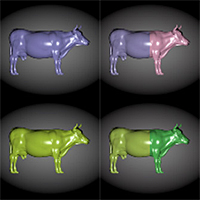Why Aren't My Photographs the Same Colors as the Original Scenes?
The most direct answer is simply that cameras are not the same as people and do not respond to color in the same way. More specifically the red, green, and blue detector sensitivities in a digital camera are not the same as, or even simply related to, the long-, middle-, and short-wavelength sensitivities of the human visual system. If they were, then computational procedures could be completed to make perfectly accurate color images from the camera data. Even if such perfect color data were recorded by a digital camera, there might still be differences due to variations in the displays and printers that we use to render our images. Lastly, even if all the above systems were perfectly accurate, we might not like the result and prefer to see a different image; perhaps one with colors that look better than the original scene (e.g., bluer sky, greener grass, nicely tanned skintones).
Image rendering, or conversion of the captured image data to displayed colors, is a step in the digital photography process that also introduces a range of possible outcomes (see images above). The data are processed in many ways to correct for properties of the image sensor, to reduce noise, to sharpen the details, to adjust for changes in illumination color and exposure, to compensate for assumed display properties, and finally to adjust to make images that the camera manufacturer feels will be more preferred. This objective of reproducing preferred colors has driven the photography industry since the beginning and is one of the main reasons that most imaging systems aren't designed to accurately reproduce the colors we see in the world; the cameras are designed to give us something we like better. Do you think they succeed all the time?
Color preferences are difficult to quantify and specify, but in general people prefer color reproductions that are accurate in hue, slightly more saturated than the original scene, and higher in contrast (the rate of change from dark to light). Pay attention to photographs that you get from your camera and print services and you will probably notice these sorts of changes. Do some experiments by taking pictures of objects you can later compare with the resulting photographs.
![]()
Explore the NEXT TOPIC at this level.
Explore the NEXT LEVEL on this topic.
Ever wonder ... How does a computer represent colors as numbers?
Updated: July 30, 2010

